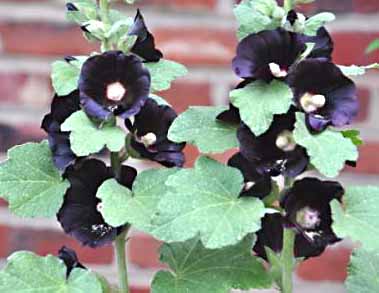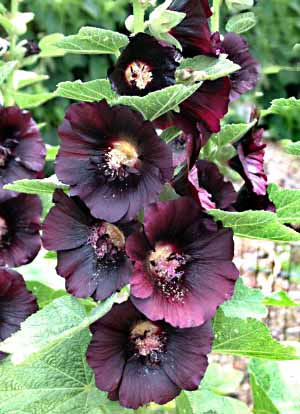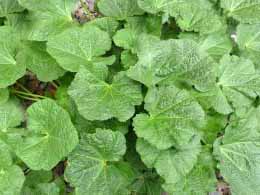Great easy to grow plant for height and drama. Tall flower spikes are great against a fence, wall or back border. The dark almost black flowers offer a good contrast and make an unusual plant. Can tolerate most soil types and needs only moderate water but must have good sunshine. Deer don't eat it, neither do rabbits. Butterflies love it.
Flowers from seed second year, may live for several years or may behave as a biannual. This is not predictable some plants may live and other from the same seed batch may not.
In early spring a small rosette of generally heart shaped mid green leaves arises. Leaves have lobed edges and rough texture with strongly defined veins. In mid spring it sends up a tall flower spike that can reach 8 feet (2.4m) in height but is more commonly between 4-6 feet .(1.2-1.8m). Each stem can produce dozens of large cup shaped dark maroon almost black flowers 3-4" (7-10cm) across that are set amongst smaller rough leaves. Flowers are produced a few at a time along the stem and flowering can last for several months. Blooms second year from seed. Sometimes plants die after blooming but many can live for several years and perform well as short lived perennials.
Indoors sow 6-8 weeks before last frost date. Surface sow on compost. Germination can be anywhere from 12-21 days depending on temperature and other conditions. Keep soil moist but not wet. Don't use an overly rich potting soil as it can encourage damping off. Since seeds are large sowing 1-2 in individual pots is the best method of sowing. Separate seedlings when large enough to handle and grow on until at least 6" (15cm) tall before gradually hardening off to outside before transplanting. For more detailed information on sowing see our General Growing Instructions.
Grow in a sheltered site as the flower stalks are long and can be blown over in high winds. Against a fence, wall or side of a building is excellent. In hotter climates - zones 8 -9 shelter from the heat, try growing on the north side of structures to help keep them cool in the heat of the summer. Staking may be necessary as stalks grow taller or they can bend and droop over. Plants can be pinched out as they begin to form stalks to encourage them to branch. This will produce more stalks of shorter height and thus more flowers.
Water daily until established then as needed during the summer months. If there is sufficient rain no other watering is necessary but if on sandy or loam soils a small daily watering can be helpful. Soaker hoses around the base of the plants are ideal.
Hollyhocks are one of the few plants that can grow beneath black walnut trees as they can resist the toxins that the tree produces.
Plants can become quite large so space at least 24-36" " (61-91cm) apart.
Mulch with at least 4" (10cm) of material in late fall to protect for the winter. Remove in early spring to allow leaves to form early. Deer resistant.
The shoots can be used to help ease difficult labor while the roots are used to treat disentary as well as inflammation of the kidneys and womb.








